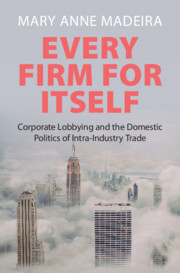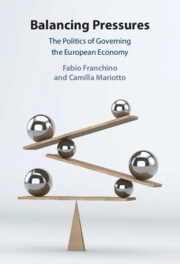Refine search
Actions for selected content:
789 results
11 - Drawing from AMR Experience for Better Prevention, Preparedness, and Response to Complex Health Threats under a One Health Approach
- from Part II - One Health and Contemporary Legal Structures
-
-
- Book:
- The Cambridge Handbook of One Health and the Law
- Published online:
- 25 September 2025
- Print publication:
- 09 October 2025, pp 157-180
-
- Chapter
-
- You have access
- HTML
- Export citation
9 - The One Health Approach and the Tackling of Drivers of Environmental Degradation
- from Part II - One Health and Contemporary Legal Structures
-
-
- Book:
- The Cambridge Handbook of One Health and the Law
- Published online:
- 25 September 2025
- Print publication:
- 09 October 2025, pp 123-138
-
- Chapter
-
- You have access
- HTML
- Export citation
6 - Like Mixing Oil and Water
- from Part I - One Health in Existing Legal Structures
-
-
- Book:
- The Cambridge Handbook of One Health and the Law
- Published online:
- 25 September 2025
- Print publication:
- 09 October 2025, pp 70-86
-
- Chapter
-
- You have access
- HTML
- Export citation
3 - One Health and the UN Animal Welfare Nexus Resolution
- from Part I - One Health in Existing Legal Structures
-
-
- Book:
- The Cambridge Handbook of One Health and the Law
- Published online:
- 25 September 2025
- Print publication:
- 09 October 2025, pp 28-39
-
- Chapter
-
- You have access
- HTML
- Export citation
The securitization of competition in the European Union
-
- Journal:
- European Law Open ,
- Published online by Cambridge University Press:
- 02 October 2025, pp. 1-16
-
- Article
-
- You have access
- Open access
- HTML
- Export citation
China’s Belt and Road Initiative and Its Impact on the Energy Independence of the European Union
-
- Journal:
- Asian Journal of Law and Society / Volume 12 / Issue 2 / June 2025
- Published online by Cambridge University Press:
- 30 September 2025, pp. 274-303
-
- Article
-
- You have access
- Open access
- HTML
- Export citation
The collective securitisation of climate change: Implications for climate adaptation policy in the United Nations and European Union
-
- Journal:
- Review of International Studies , First View
- Published online by Cambridge University Press:
- 16 September 2025, pp. 1-26
-
- Article
-
- You have access
- Open access
- HTML
- Export citation
Abusing the international solidarity principle: Human rights, international solidarity, and the EU’s bilateral migration deals
-
- Journal:
- Review of International Studies , First View
- Published online by Cambridge University Press:
- 01 September 2025, pp. 1-22
-
- Article
-
- You have access
- Open access
- HTML
- Export citation
EU’s Extraterritorial Obligations for Global Medicine Access Under the Convention on the Rights of Persons with Disability (CPRD)
-
- Journal:
- Journal of Law, Medicine & Ethics / Volume 53 / Issue 3 / Fall 2025
- Published online by Cambridge University Press:
- 29 August 2025, pp. 356-364
- Print publication:
- Fall 2025
-
- Article
-
- You have access
- Open access
- HTML
- Export citation
Under Cover: Substituting Formal IOs during Hard Times
-
- Journal:
- Ethics & International Affairs / Volume 39 / Issue 2 / Summer 2025
- Published online by Cambridge University Press:
- 22 August 2025, pp. 130-144
-
- Article
-
- You have access
- Open access
- HTML
- Export citation
5 - Lobbying over Trade Policy in the European Union
-
- Book:
- Every Firm for Itself
- Published online:
- 21 July 2025
- Print publication:
- 07 August 2025, pp 87-115
-
- Chapter
- Export citation

Every Firm for Itself
- Corporate Lobbying and the Domestic Politics of Intra-Industry Trade
-
- Published online:
- 21 July 2025
- Print publication:
- 07 August 2025
Analysis of heavy metal content in protein powders available on the Hungarian market: a reassuring snapshot, but not a reassuring quality guarantee
-
- Journal:
- Journal of Nutritional Science / Volume 14 / 2025
- Published online by Cambridge University Press:
- 16 July 2025, e49
-
- Article
-
- You have access
- Open access
- HTML
- Export citation
Critical minerals policies need clearer interface with scientifically credible targets
-
- Journal:
- Global Sustainability / Volume 8 / 2025
- Published online by Cambridge University Press:
- 14 July 2025, e25
-
- Article
-
- You have access
- Open access
- HTML
- Export citation
3 - Reducing Inequality in Consumer Transactions
-
-
- Book:
- Legal Heterodoxy in the Global South
- Published online:
- 19 June 2025
- Print publication:
- 03 July 2025, pp 77-111
-
- Chapter
-
- You have access
- Open access
- HTML
- Export citation
Women’s political empowerment moderates socio-economic drivers of child poverty: Evidence from EU nations
-
- Journal:
- Journal of International and Comparative Social Policy / Volume 41 / Issue 1 / March 2025
- Published online by Cambridge University Press:
- 19 June 2025, pp. 63-78
-
- Article
-
- You have access
- Open access
- HTML
- Export citation
Chapter 16 - TARGET2-Securities
- from Part III - Organizations and Actors of Contemporary Financial Infrastructures
-
-
- Book:
- The Cambridge Global Handbook of Financial Infrastructure
- Published online:
- 21 May 2025
- Print publication:
- 05 June 2025, pp 192-208
-
- Chapter
-
- You have access
- Open access
- HTML
- Export citation
1 - Governing the European Economy as Balancing Pressures
-
- Book:
- Balancing Pressures
- Published online:
- 02 May 2025
- Print publication:
- 22 May 2025, pp 1-22
-
- Chapter
- Export citation
6 - Liberal Governance and Its Contestation in the European Union
- from Part III
-
- Book:
- Representants and International Orders
- Published online:
- 15 May 2025
- Print publication:
- 08 May 2025, pp 199-248
-
- Chapter
- Export citation

Balancing Pressures
- The Politics of Governing the European Economy
-
- Published online:
- 02 May 2025
- Print publication:
- 22 May 2025
